Photodynamic Therapy
Discover the advanced light treatment of photodynamic therapy.
Personalised PDT Treatment with Dr. Tina Fang
Dr. Tina Fang is known for her expertise and innovative approach to Photodynamic Therapy (PDT), a treatment for skin conditions like sun damage, solar keratoses, and certain superficial skin cancers such as Intraepithelial Carcinomas (IECs) and superficial Basal Cell Carcinomas (BCCs).
Unlike set treatment protocols, Dr. Fang tailors each PDT plan to the unique needs of the patient, continually refining her methods based on patient feedback to optimize skin health outcomes.
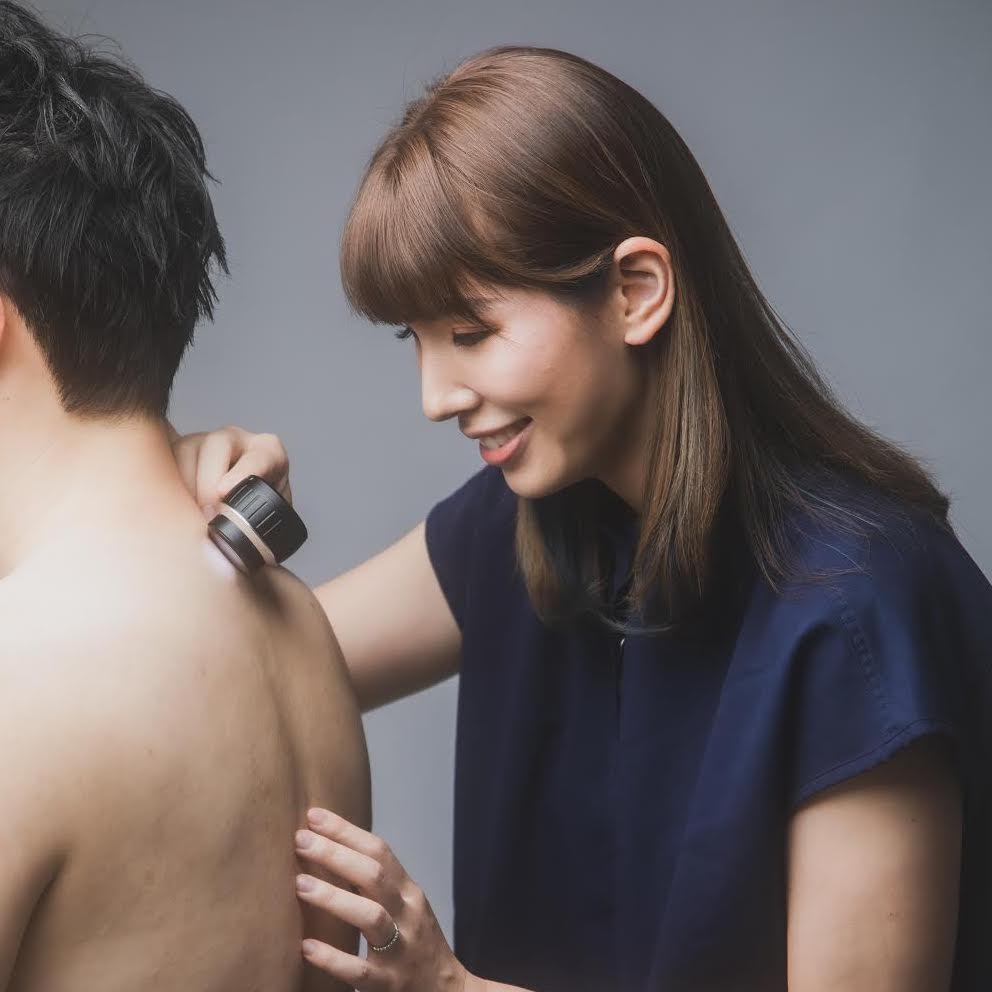
Photodynamic Therapy: A Novel Approach for Treating Skin Cancer
How PDT works: Photodynamic Therapy involves applying a photosensitive medication to the skin, which is then activated by a specific wavelength of light. This process destroys cancerous and precancerous cells while sparing healthy tissue.
Key points of Photodynamic Therapy
One-day treatment (3 hours).
5 days of recovery.
More effective compared to prescription topical treatments.
Skin rejuvenation is a hidden bonus of this treatment.
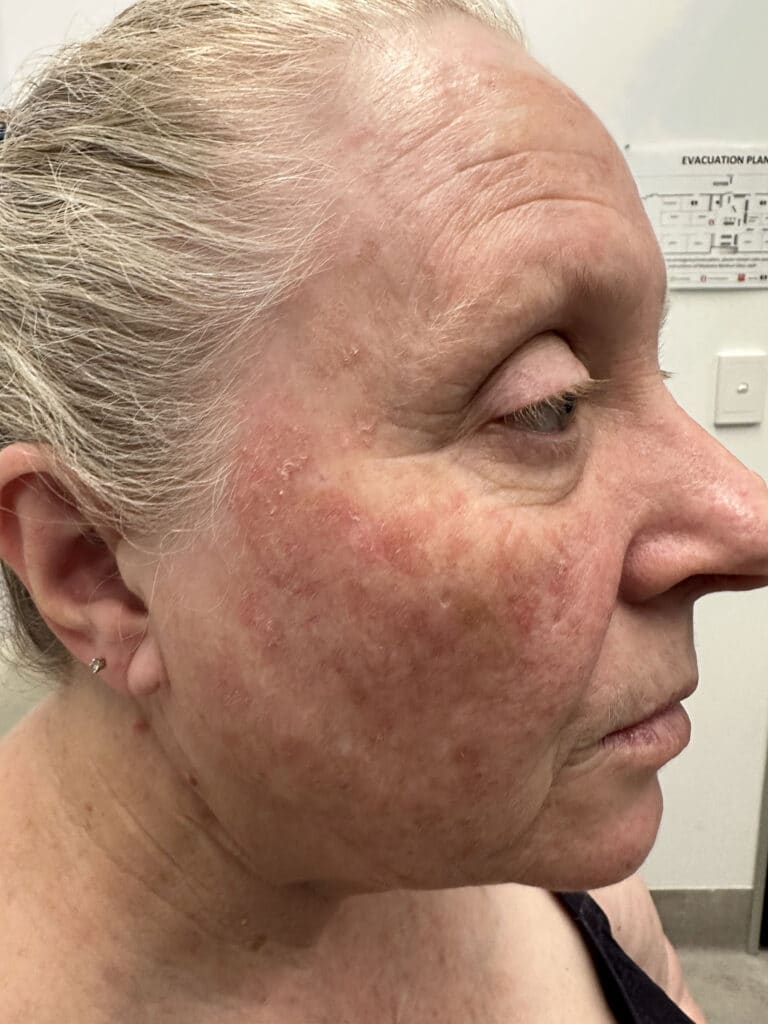
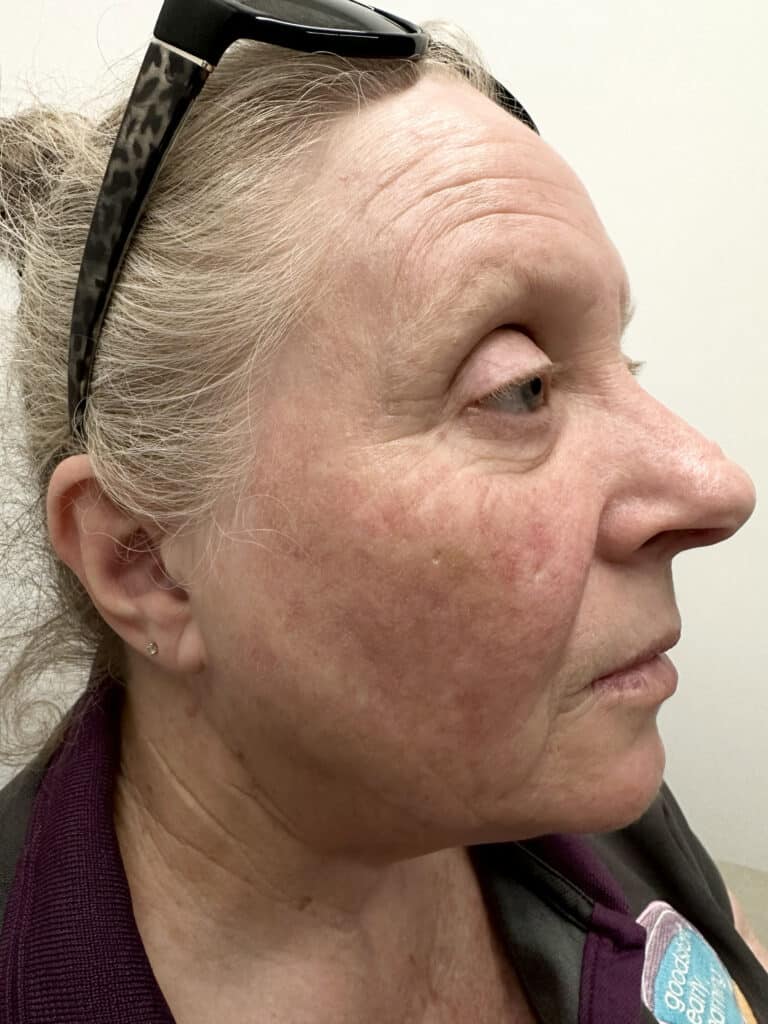
PDT Treatment Key Information
Photodynamic Therapy is effective and safe for treating:
- Actinic Keratosis (Solar Keratosis)
- Superficial Basal Cell Carcinomas
- Early stages of Squamous Cell Carcinoma, referred to as Bowen Disease or Squamous Cell Cancer in situ/IEC Cancer
Sunspots, Solar Keratosis, Actinic Keratosis
- PDT has a clearance rate of approximately 80% with remissions lasting from 6-18 months. Dr Fang combines Laser (Fractional resurfacing) to increase the clearance rates.
Superficial Skin Cancers
- Two sessions of PDT offer a remission rate of 60-85%, in some cases, Dr Fang will surgically scrap the lesion prior to achieve higher clearance rate.
Once the local anaesthetic has worn off you may find that there is a mild discomfort. This is usually helped by taking Paracetamol. Follow the instructions on the packet.
Please do not take Ibuprofen or Aspirin because this can increase the risk of bleeding.
Before PDT
Recent evidence suggests that using high-dose oral vitamin D for 7 days before the treatment may enhance the effectiveness of topical PDT.
Creams like urea or salicylic acid can be used for a week to remove thickened skin and help the drug penetrate better
Application
You skin will be cleaned and prepped. Some thickened lesions may be scrapped.Â
Photosensitising agent (Aminolevulinic acid) is applied to the affected area.
Incubation
The photosensitising agent will concentrate in the cancer cells, it usually takes 1 to 3 hours.
Activation
A laser or non-laser light is directed onto the treated area.
The treatment lasts for a certain duration, typically 20-30 minutes with artificial light or 2 hours with daylight.
Shorter Downtime
PDT typically requires just a single session. The recovery time averages between 5-7 days. This is significantly less than the 3-4 weeks for Efudix treatment and 4-8 weeks for Aldara treatment.
Efficiency
– Sunspots and solar keratosis: 1 PDT session is usually sufficient.
– Superficial Basal Cell Carcinoma and IECs: 2 PDT sessions may be necessary, with a flexible scheduling range of 1 to 10 weeks apart.
Versatile Follow-up
For any residual areas: options include treatment with lasers, liquid nitrogen, or a second course of PDT.
Clearance Rates
PDT and Efudix have similar effectiveness for treating solar
keratosis, with clearance rates above 75%. Laser-assisted PDT can achieve even
higher clearance rates, around 85%.
Recovery Time: PDT boasts the quickest recovery period, approximately 6 days,
compared to Efudix which has a 4-week recovery timeframe.
- Patients might need to avoid certain medications and supplements that could affect sensitivity to light.
- Antibiotics: Particularly fluoroquinolones (eg. ciprofloxacin) and tetracyclines (eg. doxycycline).
- Non-steroidal Anti-inflammatory Drugs (NSAIDs): Such as naproxen and ibuprofen.
- Diuretics: For example, hydrochlorothiazide and furosemide, which are used to treat high blood pressure and edema.
- Psychiatric Medications: Certain antidepressants, including some tricyclic antidepressants (e.g. amitriptyline) and antipsychotics.
- Antifungals: Such as voriconazole and itraconazole.
- Chemotherapy Drugs: For instance, dacarbazine and fluorouracil.
- Heart Medications: Including amiodarone, which is used for certain types of Irregular heartbeats.
- Supplements: St. John’s Wort is particularly known for increasing photosensitivity.
- Retinoids: Including acitretin and isotretinoin, used for psoriasis and severe acne, respectively.
- Sulfonylureas: Oral hypoglycemic agents like glimepiride, used in diabetes management.
Side effects include light sensitivity lasting about 24 hours, burning/stinging sensations, swelling, redness, crusting, itchiness, peeling, blisters, and potential skin infections. The treated area must be protected from light to manage photosensitivity. While scarring is generally minimal, there is a risk of pigmentation loss which can sometimes be permanent.
Side effects may include –
- Burning/stinging sensation
- Swelling and redness
- Crusting
- Itchiness
- Peeling and blisters
- Skin infections
The treated skin lesion may blister and ulcerate as the cancer cells die off. This may take 1-2 weeks to heal. The treated area must be protected from light to manage photosensitivity. While scarring is generally minimal, there is a risk of pigmentation loss which can sometimes be permanent.
Depending on the type of lesion being treated and the photosensitising chemical used, a 2nd cycle of treatment may be given 7–10 days later.
Post-treatment, the area should be kept covered to protect it from light. Any discomfort can often be managed with over-the-counter pain relief.
Patients are advised to follow specific aftercare instructions to support healing. This includes prescription topical anti-inflammatory cream and/or prescription antibacterial cream. Patients are encouraged to report any signs of infection or unusual side effects to the clinic. Zinc-based sunscreen will be provided after your treatment for the next 7 days for you to travel to places.
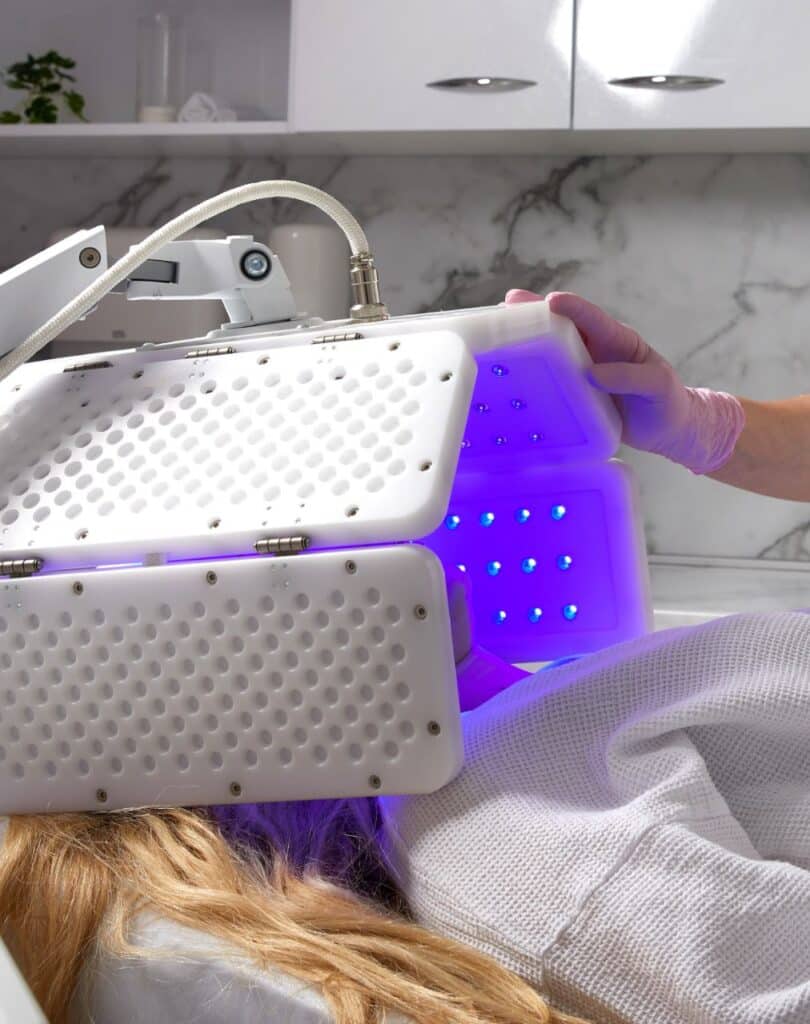
Preparing for your Photodynamic Therapy Session
Medications to Avoid
Certain medications and supplements increase sensitivity to light and should be avoided before undergoing PDT:
Antibiotics: Especially fluoroquinolones like ciprofloxacin and tetracyclines such as doxycycline.
NSAIDs: Such as naproxen and ibuprofen.
Diuretics: Like hydrochlorothiazide and furosemide.
Psychiatric Medications: Certain antidepressants and antipsychotics.
Antifungals: Including voriconazole and itraconazole.
Chemotherapy Drugs: Such as dacarbazine and fluorouracil.
Heart Medications: Amiodarone, used for irregular heartbeats. Supplements: St. John’s Wort, known for increasing photosensitivity.
Retinoids: Used for psoriasis and severe acne.
Sulfonylureas: Diabetes medications like glimepiride.
Post-Treatment Care
Aftercare Instructions
Keep the treated area covered to protect it from light exposure.
Manage discomfort with over-the-counter pain relief if necessary.
Follow specific instructions for applying prescription topical anti-inflammatory and antibacterial creams.
Use the provided zinc-based sunscreen for at least 7 days post-treatment to protect the area when outside.
Monitoring and Follow-up: Patients should monitor the treatment site for any signs of infection or unusual side effects and report these to the clinic promptly.
Dr. Fang’s personalised approach to PDT not only treats skin conditions effectively but also focuses on enhancing the patient’s overall skin health, ensuring that each treatment is perfectly suited to their individual needs.
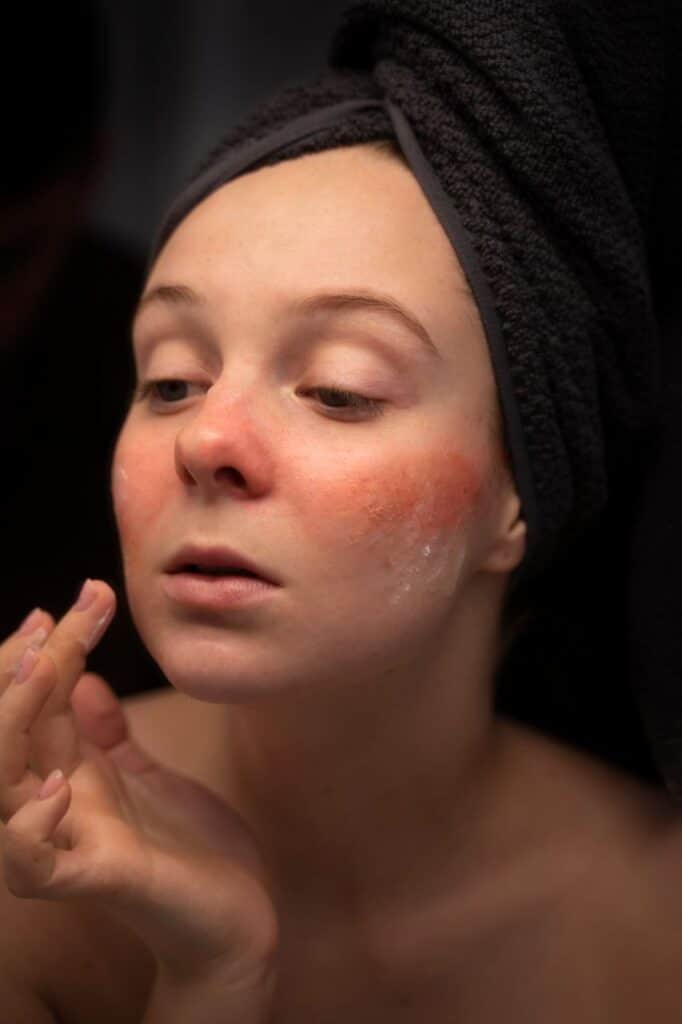
Book Now. No referrals required.
Our Skin Check, Cosmetic and Laser services are confidential, gentle and friendly to ensure patient comfort and safety throughout the whole process. Our experienced doctors will guide you and expert advice, so you can make confident and informed decisions.

